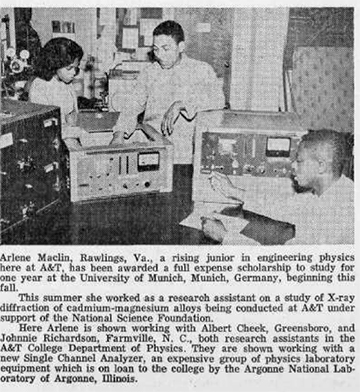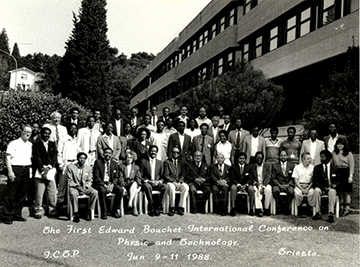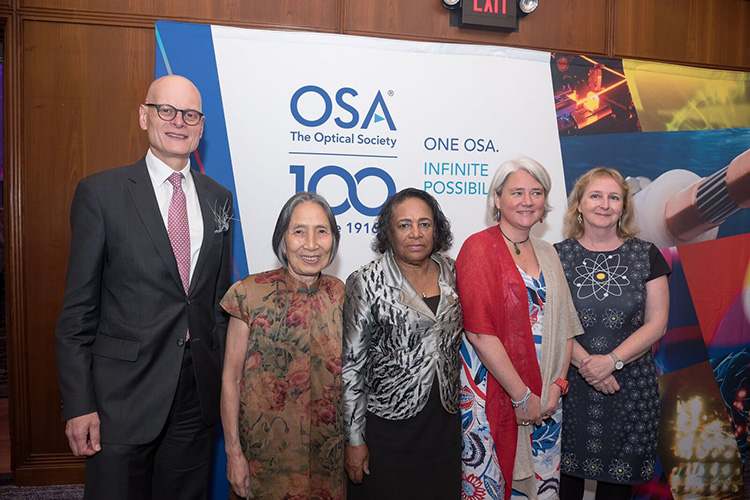
2018 OSA President Ian Walmsley (left) with 2018 Optica Diversity & Inclusion Advocacy Recognition winners Ling-An Wu, Arlene Maclin and Frederique Vanholsbeeck, and Síle Nic Chormaic representing a winning institution, the Okinawa Institute of Science & Technology. [Image: Optica]
Editor’s note: In a May 2023 feature article, “Breaking Barriers, Advancing Optics,” Optics & Photonics News profiled six Black scientists in the United States, their pathbreaking work in optics, photonics and related areas, and their perspectives on progress and challenges for underrepresented groups in science. In this special accompanying online “Conversations” series, we offer edited versions of the interviews behind those profiles.
In this installment, OPN chats with Arlene Maclin, president and CEO of MacSmith STEM Enterprises, USA.
You were only the third Black woman in the United States to receive a Ph.D. in physics.
Arlene Maclin: Yes. I happened to be the third as we know it, and I was the first Black woman to get a Ph.D. at Howard in physics. But, you know, I’m against this numbering system. Go by generations, like, the people who got degrees in the ‘70s will be the first generation. That makes a lot more sense.
But I mean, over 50 years, just barely 100 Black women got physics Ph.D.s. The situation is very similar for Hispanic women. And of course, for American Indian women, the numbers are just unbelievably low.
Was it difficult, then, finding role models to look up to as a Black woman and aspiring physicist?
I was fortunate in that I went to North Carolina A&T University. And I had a brilliant professor, Alexander Gardner, who was a pioneer in terms of mentoring students. He introduced me to Fay Ajzenberg-Selove, who was a very distinguished woman physicist. Fay was the first woman physicist that I ever met. And after I met her in my sophomore year, I spent a year at Haverford where she worked, and I got to know her and her husband very well. And they were just so unbelievably kind to me. I maintained contact with her and was mentored by her throughout my career.
So I have had an unusually good experience in terms of mentoring. I mean, I’ve had bad experiences as well. But I’ve had some great mentoring experiences.
What aspects of her mentoring proved useful for you?
She was a very distinguished physicist. I didn’t realize how distinguished she was, frankly, when I first met her. In 2007, four years before she died, she was awarded the National Medal of Science for all of the work that she had done in nuclear physics. So as I got to know her, I realized she was just an all-around great person. In fact, when I was a graduate student, she and her husband invited me every year to dinners with all these distinguished scientists in nuclear physics. And I was the only student that she invited. That’s highly unusual.
She also knew what women needed because she had not had an easy time being a woman physicist. She actually had to sue the University of Pennsylvania for discrimination.
Who else influenced you early in your career?
Another pioneering woman I got to meet was Patricia Cladis, who worked on liquid crystal displays at Bell Labs. When I got to graduate school, I did solid-state condensed matter. So my first encounter with optics was my Ph.D. dissertation work, in which I did computational studies of gallium. It turns out that gallium was one of the primary liquid metals used in the first LCDs. My work was a part of the research that led to LCDs on small personal computers in the 1980s.
A 1965 news article featuring Arlene Maclin. [Image: Courtesy of A. Maclin] [Enlarge image]
And through that research is how I met Pat as a graduate student. Pat Cladis and Bell Labs were leaders in that field. In 1972, I think, at an APS March meeting, she came to my talk, which I was very flattered by. We got into discussions afterward, and then we became friends and colleagues. She became another unintended mentor. Through her, I got access to Bell Labs people, and it was just marvelous. So I had these very lovely women mentors.
I’ve had some great male mentors, too. As I mentioned, Alex Gardner, who was at North Carolina A&T, was an unbelievable mentor to a large number of Black students. I think about 40 of his students had gotten Ph.D.s in physics.
What drew you to nuclear and condensed matter physics?
I grew up on a farm in Virginia. In high school, I had a fabulous math teacher, who could have been put in the Hidden Figures category. And frankly, I’d always thought that I was going to become a mathematician because I just loved mathematics, until I took physics in the 11th grade.
The physics course I took was not good. But for the first time, I saw how mathematics was being used. And that’s when I made the decision. If I went on to college—I was the first in my family to go to college—I said, I want to do physics. Physics is what I want to do for the rest of my life. And I just happen to have met people in that pathway who facilitated that and made that possible.
After you finished your Ph.D., you worked in a wide variety of different places.
You’re right. I’ve worked in a number of settings. Right after my Ph.D., I went to the MIT Lincoln Laboratory, and that was not a good experience for me. I had to wait for three months to get my security clearance. Then I found it to be a very militaristic environment where I really felt very isolated. So I only stayed there one year.
The only woman who had been there before me was Millie Dresselhaus. I learned later that, similarly, she had not had a good experience. In fact, she left the Lincoln Lab and went to the university.
After maybe four or five months of this isolation, I started going over to MIT and met people there who were very accommodating. I would meet people for lunch, and I just spent less time at the lab. I now caution younger people, “Do not go into an environment in which you really don’t know what you’re going to be doing.”
You also had government positions. How did you find those experiences?
First, I was a congressional fellow at the OTA [US Congressional Office of Technology Assessment]. And that was a great experience. I mean, we were a great community of scientists and engineers. This was during the Carter administration, and we were doing all these studies, such as a residential energy study. And I got to meet other young scholars in various fields—economics, physics, mathematics—and we all got along.
We also had direct access to people on the Hill. The OTA at that time had six members from the Republican Party and six members from the Democratic Party. And when I was there, Ted Kennedy was the chair of the Technology Assessment board. So we got to meet with him. All the members came over to our office maybe twice a year, and we interacted with their staff on a regular basis. So I was almost like a congressional staffer. That’s the way we operated. That was a very interesting time.
You also had other interesting government roles: a program manager role at the NSF and a similar role at the National Research Council. Could you talk about those experiences?
After my OTA congressional fellowship, I got a call from Shirley McBay, who was at the NSF at that time. She asked me to come to the NSF to help out with the Minority Science and Engineering Program. So I joined that as a staff member, not knowing what was about to come. I was there for a little over a year, and then Reagan decided that he was going to do away with all science education programs at the National Science Foundation. The whole science education directory was wiped out except for our program, which was protected. But it was moved over to the Department of Education.
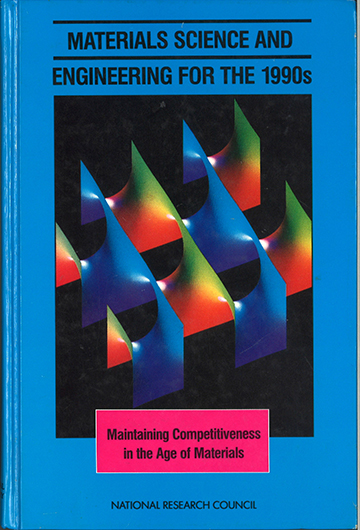
The cover of Materials Science and Engineering for the 1990s: Maintaining Competitiveness in the Age of Materials from the National Research Council. [Image: Courtesy of A. Maclin]
Honestly, I didn’t see that as being protected. We were isolated from the rest of the science education community, and that was not good. That problem still exists, unfortunately. The program has not grown the way the NSF programs have grown.
Later, I joined the National Research Council, which was a very good experience. I was the main program person for the study that defined the field of materials science and engineering and brought together all the materials science people from all over the country. Before that, you had solid-state chemists, solid-state physicists, metallurgists and surface ceramicists—all separate. And we brought them together. Since the field of materials science and engineering emerged, it has grown even bigger than the physics world.
It sounds like there was a lot of work behind the scenes.
It was an enormous amount of work. But I got to meet and interact with people like James Langer, who is just an unbelievably brilliant scientist. I got to interact with him one on one, which was the highlight of my entire career—getting to know him and working with him. And he was very passionate about the study and worked very hard on it. And because I worked with him, I went out to Santa Barbara several times to meet with him and his staff.
I think we’ve made a great impact on science policy, which is extremely important. Sometimes, you have to be at the table to help make decisions. And I certainly was at the table for that study.
Are there areas of research you’ve been involved in where you think your work has been particularly impactful?
Yeah—I can now talk about the work that I did at the CIA, which, for 20 years, I couldn’t talk about. At the CIA, my job was leading the very high-speed integrated-circuit program. I worked in gallium arsenide and managed US$30 million on various projects. And I got to meet and work with people from places like McDonnell Douglas, Hughes Research Lab, Westinghouse—all the big aerospace companies.
When I got to the CIA in late 1981, a silicon chip only had 10 transistors on it. And in just two years, I moved that technology from 10 transistors to over 100,000. I was directing the work. My mission at the CIA was to develop a smaller, lower-powered concealable data-collection device. We didn’t make the concealable part, but we made the rest of it. Now we have these highly integrated systems, but none of that was possible in the ‘80s.
I got to work with people all over the country and the world. I even went to Japan several times on the US government’s dime. One time, I was in a delegation to Fujitsu in late 1982. And there were eight men and me. That was always the case, by the way—I was typically the only woman in the US delegation.
Fujitsu was developing a high-speed supercomputer at that time. And the Japanese were ahead of us. So we went to Fujitsu and had a meeting with Fujitsu’s lead scientist and an interpreter. And during the meeting, I really didn’t say very much because, as usual, the men in the group were dominating the conversation and showing off how much they knew. There were people from DARPA [US Defense Advanced Research Projects Agency], DoD [US Department of Defense], CIA—all of it.
At the end, the lead scientist looked at me, and he said, “Do you have a question?” And I said, “Yes, I do.” And he said, “What’s your question?” So I said, “Do you have the specifications and a picture of the supercomputer that you’re building?” A very simple question. To everybody’s surprise, he gets up and goes into the closet. And he brings out this poster-sized picture of the computer with all the specs on it, puts it in a tube and gives it to me.
You gotta ask.
You gotta ask. Nobody asked the main question. A man from the CIA had been trying to figure out what the Japanese were doing for four years. And here I was, at a meeting, asking the very question that everyone wanted to ask but didn’t. They were asking about all this technical stuff, going back and forth. I mean, there was just an unbelievable amount of testosterone in the room.
But I just asked the simple question at the end. So that tells you how important it is to have diversity, because had I not been a part of the delegation, I suspect we would not have gotten the picture with all the specs.
A group photo from the first Edward Bouchet International Conference on Physics and Technology, held in 1988. The event was organized by Joseph Johnson, one of the founding members of the the National Society of Black Physicists, and Abdus Salam, who won the 1979 Nobel Prize in Physics, to unite African and African American scientists. [Image: © ICTP Photo Archives] [Enlarge image]
The milestone of moving from 10 to 100,000 transistors on a particular integrated circuit really speaks to the huge amount of progress that’s been made in information technology. Did the progress stay within the agency?
No, that did not stay with the government, which is the reason we have the iPhone. Apple, IBM—all these companies made use of it. The high-speed integrated circuit issue was solved really by DARPA and the CIA, and then it was given to anybody who wanted it. So now, anybody can have these very highly integrated circuits. You get this applicability that you would not have had without that high integration, and of course, the compactness of it all.
That also moved the field to what we now know as nanoscience. Obviously, it was not nanoscience then, it was micro-electronics at the time, but we were moving toward sub-micron devices, which was very important in terms of getting these small devices that we now take for granted.
Could you talk about the optics-related programs that you started?
I went to Hampton University in 1992 to start a Ph.D. program in optics. It turns out that six months before I got there, Hampton had submitted a proposal for minority-serving institutions and received funding from NASA for US$8.5 million over five years. But the person who wrote the proposal left the university soon after the proposal was submitted, so that program languished for six months after it had been funded. And NASA was about to take the money back.
So I got called in to be the clean-up person. When I got to Hampton, there were no labs. I’m not trying to sound like I was super woman, but I worked 15 to 16 hours a day, trying to save this program. And I recruited Don Lyons, who was at Grumman Aerospace Corporation and had done a lot of work in fiber optics.
During this time, I consulted with other people in the field of optics, like Anthony Johnson and Peter Delfyett, about the ways to equip the laboratory because I was a theoretician. But still, I would say that we had the best university optics laboratories anywhere. We had very highly equipped laboratories. Coherent was a very willing partner. They took our students to California and gave them training on how the lasers should work.
Our program’s collaboration with NASA was very critical. I had full access to and support of the people at NASA. I could just walk into the office of Paul Holloway, NASA Langley’s center director at that time, and say “I need this.” NASA gave us full online access to its library, which was pretty unusual.
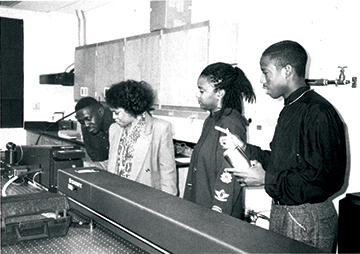
Arlene Maclin (second from left) with students in a physics laboratory. [Image: Hampton University Alumni Magazine]
So I had the full support of all of the community, except the university. I had recruited all these students, and most of them went on to get Ph.D.s. But the problem was that the university did not really understand what was required to put together a first-class program. So Don Lyons stayed at Hampton, and I left after two and a half years.
You also started an optical engineering program at Norfolk State, which sounds like a very impressive accomplishment.
It was an impressive accomplishment. This time, we had full support. The then-president of Norfolk State wasn’t a scientist, but it was her idea to start a program. She had gone to NASA to ask for funding, and we worked very well with NASA on the program.
We had three labs and they were very well equipped—Newport tables and all that. Over the period of eight years, I recruited over 100 students. We were the only undergraduate optics program at a Black college in the country. And I collaborated with the best optics programs in the country: University of Arizona, Virginia Tech, University of Alabama and Rose-Hulman Institute of Technology. I decided to work with them because I thought, the only way I’m going to move this program forward is to collaborate with people who already have a program.
Those collaborations led Norfolk State to become a part of the NSF Engineering Research Center at the University of Arizona. Our students were involved in that program, so some of the students went on to graduate school at Arizona. In that collaboration, we also had people from the University of California, San Diego, so I could make connections with them, too. Virginia Tech, too, of course, was a very willing partner. Our students had internships at those schools and several went to graduate schools at those universities.
I said every undergraduate student should have an internship at a major research university, an internship in a national lab and an international experience. And I made sure those things happened for students. So students even got to go to CERN for the summer.
During my time at Norfolk State—I’m bragging a little bit now—94% of the students that I recruited to that program got degrees in engineering. That’s unheard of. And many of them got jobs all over. I made the necessary connections to facilitate the careers of the students. CIA snapped up a whole lot of them because I also got a grant from the Office of the Director of National Intelligence at the same time. And the students have done very well. I didn’t have a single student who I recruited who did not complete the program, except for one who had to drop out because of an illness. But a 94% graduation rate—highly unusual.
You started MacSmith STEM Enterprises a few years ago. What’s the goal of that venture?
It’s really to continue what I was doing before. I have continued to mentor women virtually as well as in person. And we [Maclin and Sonya Smith] are working on trying to get MacSmith launched so that we can help more minority women get Ph.D.s. The venture is a nonprofit. We’ve submitted several proposals, and I’m working on one right now that could move us to the next level. Everything takes money. I’ve been using some of my own resources, but you can’t do that for long.
Getting Ph.D.s in physics and engineering—many of the young women that I’ve talked to say it is still a very bumpy road for most. I’ve heard some pretty nasty stories from young women, who said they’re just not staying in physics. They say, “I’m going to get the degree, but I’m not staying in physics.” That’s how bad the situation is.
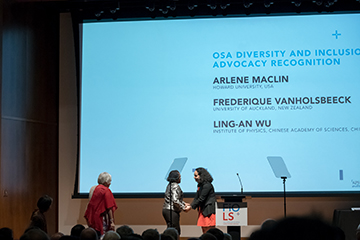
Arlene Maclin (middle) receiving the 2018 Optica Diversity & Inclusion Advocacy Recognition at FiO 2018. [Image: Optica]
And is that simply because physics is so male-dominated?
Part of it is that. Unfortunately, not much has changed in 50 years. Young women are still experiencing the issues of harassment, invisibility, imposter syndrome—that kind of stuff. They still exist in the physics community. It hasn’t changed much, and it’s very difficult to change.
I just read an article about the situation in physics and how it is bad for women, period. And for Black women and other minority women, it’s even worse. They’re not considered equals, and they’re having very bad mentoring experiences. Something has to change because there are more Black women graduating from college in STEM than there are Black men. We have to move the needle. I don’t know how, but it has only moved a very small amount in over 50 years now.
But if you were to suggest a solution, what would that be?
Intensive mentoring, because a lot of these women are dispersed, and they just have nowhere to turn. So they think, “I’m getting out of here, I’m not going to stay in this field.” Of course, we already know that a large number of these women leave. For example, they leave engineering after five years and then go into finance. Physicists, I don’t even know—there are too few to even tell.
You mentioned that physics is a particularly hostile environment for women and particularly for minority women. Are there lessons to be drawn from other STEM fields that might have a little more success?
I think there may be a larger number of female students and fewer issues in mathematics than in other STEM fields. This is all speculative, but I think the reason for that is because it’s theoretical. You don’t have to go into the lab to do your work. For whatever reason, women—certainly Black women—seemed to have a lot more success in mathematics than in physics or engineering. I suspect it’s probably because it’s a less hostile environment. I don’t have any evidence to support that. But that’s my guess. The number of Black women in mathematics is still too few, of course, but they don’t seem to have the same issues that women in physics and engineering seem to have.
You went to HBCUs, and you worked in HBCUs. How have these institutions shaped your career?
Well, as I mentioned earlier, I had an unbelievable undergraduate mentor, Alex Gardner at North Carolina A&T. He had just finished his Ph.D. at the University of North Carolina at Chapel Hill. Then he came to A&T as a very young professor, as his first job. He stayed at A&T and then went on to Howard. His whole career goal was to make sure that he increased the number of minority students who went on to get Ph.D.s in physics. And he certainly did that. He was a pioneer who completely changed the curriculum at A&T. So when we finished the undergraduate program at A&T, we were ready and equipped to compete in the larger market and go to graduate schools. The students went and got graduate degrees at Stanford, MIT, Harvard—everywhere.
Frankly, if I had gone to another type of school as an undergraduate, I do not think I could have been successful. I probably would have given up physics because I would not have had the kind of support that I needed. I had extraordinary mentoring. I’m deeply grateful to A&T for that.

